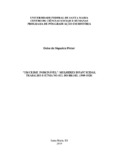| dc.creator | Pötter, Deise de Siqueira | |
| dc.date.accessioned | 2021-05-07T11:25:00Z | |
| dc.date.available | 2021-05-07T11:25:00Z | |
| dc.date.issued | 2019-08-28 | |
| dc.identifier.uri | http://repositorio.ufsm.br/handle/1/20810 | |
| dc.description.abstract | This study is part of the work on the Frontier, Politics and Society research line, which is linked to the
Postgraduate Program in History of the Federal University of Santa Maria (PPGH-UFSM). The proposed
research has as its theme the women who were accused of the crime of infanticide in the south of the country in
the first decades of the twentieth century, in this sense, the research focuses more precisely Alegrete, Sant'Ana
do Livramento and Dom Pedrito. The spatial choice was due to the inexistence of studies on the subject in the
region. With respect to the temporal cut, this had as its initial beacon the Criminal Code of the United States of
Brazil, which came into force in 1890 and lasted until 1940. Based on this period, fifteen criminal cases (1909-
1939) were found in the State Public Archive of Rio Grande do Sul - APERS. The treatment of these sources is
based on analyzes of the qualitative aspects, considering possible contradictions that the document may present,
among other specific dangers of documentation. That said, the discussion focuses on the analysis of infanticide
crimes and their relationship to honor, as well as gender, ethnicity, and work. For this, it is necessary to: a)
Evidence of what the society of the analyzed period comprised by family, honor and their relation and
implications with the gender; b) Know the history of some women who did not follow the moral standards
stipulated for the period and ended with an unwanted pregnancy and the solutions they found to end their
problem; c) Know the role of the complainant through the initiation of police investigations, as well as their
profile; d) To understand how the knowledge of Legal Medicine was being incorporated in the juridical field and
its importance in the search for the truth through the bodies; e) To verify the outcomes given to the crimes of
infanticide, observing the speeches alleged in defense of the grounds. | eng |
| dc.description.sponsorship | Coordenação de Aperfeiçoamento de Pessoal de Nível Superior - CAPES | por |
| dc.language | por | por |
| dc.publisher | Universidade Federal de Santa Maria | por |
| dc.rights | Attribution-NonCommercial-NoDerivatives 4.0 International | * |
| dc.rights.uri | http://creativecommons.org/licenses/by-nc-nd/4.0/ | * |
| dc.subject | Crime | por |
| dc.subject | Infanticídio | por |
| dc.subject | Processos-crime | por |
| dc.subject | Infanticide | eng |
| dc.subject | Criminal proceedings | eng |
| dc.title | “Um crime inominável”: mulheres infanticidas, trabalho e etnia no sul do Brasil (1909-1928) | por |
| dc.title.alternative | "An inominable crime": children, work and ethnicity in the south of Brazil (1909-1928)s | eng |
| dc.type | Dissertação | por |
| dc.description.resumo | Esse estudo é integrado aos trabalhos em desenvolvimento na linha de pesquisa Fronteira, Política e Sociedade, vinculado ao Programa de Pós-Graduação em História da Universidade Federal de Santa Maria (PPGH-UFSM). A pesquisa proposta tem como tema as mulheres que foram acusadas pelo crime de infanticídio no sul do país, nas primeiras décadas do século XX, nesse sentido, a pesquisa enfoca mais precisamente Alegrete, Sant‟Ana do Livramento e Dom Pedrito. A escolha espacial deu-se em decorrência da inexistência de estudos sobre o tema na região. Com relação ao recorte temporal esse teve como baliza inicial o Código Penal dos Estados Unidos do Brasil que entrou em vigor no ano de 1890 e durou até 1940. Com base nesse período foram encontrados quinze processos criminais (1909-1939) no Arquivo Público Estadual do Rio Grande do Sul – APERS. O tratamento dessas fontes se baseia em análises dos aspectos qualitativos, atentando para possíveis contradições que o documento possa apresentar, entre outros perigos específicos da documentação. Dito isso, a discussão centra-se na análise dos crimes de infanticídio e a sua relação com a honra, assim como o gênero, a etnia e o trabalho. Para isso, se faz necessário: a) Evidenciar o que a sociedade do período analisado compreendia por família, honra e sua relação e implicações com o gênero; b) Conhecer a história de algumas mulheres que não seguiram os padrões morais estipulados para o período e acabaram com uma gravidez indesejada e as soluções por elas encontradas para dar fim ao seu problema; c) Conhecer o papel do denunciante
mediante a instauração das investigações policiais, bem como o seu perfil; d) Compreender como o saber da Medicina Legal foram sendo incorporados no campo jurídico e sua importância na busca pela verdade através dos corpos; e) Verificar os desfechos dados aos crimes de infanticídio, observando os discursos alegados em defesa das rés. | por |
| dc.contributor.advisor1 | Flores, Mariana Flores da Cunha Thompson | |
| dc.contributor.advisor1Lattes | http://lattes.cnpq.br/0741500213422724 | por |
| dc.contributor.referee1 | Calandria, Maria Sol | |
| dc.contributor.referee2 | Witter, Nikelen Acosta | |
| dc.contributor.referee3 | Weber, Beatriz Teixeira | |
| dc.creator.Lattes | http://lattes.cnpq.br/6129538458821046 | por |
| dc.publisher.country | Brasil | por |
| dc.publisher.department | História | por |
| dc.publisher.initials | UFSM | por |
| dc.publisher.program | Programa de Pós-Graduação em História | por |
| dc.subject.cnpq | CNPQ::CIENCIAS HUMANAS::HISTORIA | por |
| dc.publisher.unidade | Centro de Ciências Sociais e Humanas | por |



